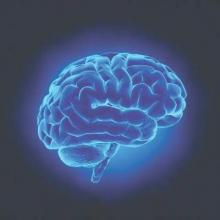SAN FRANCISCO – Frontal cortical thinning was common in late-life depression but generally did not predict executive dysfunction, according to magnetic resonance imaging studies of 157 adults.
The only exception was the left middle fronto-orbital gyrus. Thinning there predicted significantly worse performance on tests of executive function and processing speed, said Krista Farley of the late-life depression program at the University of California, San Francisco. Based on this limited finding, “further investigation of the etiology of executive dysfunction in late-life depression is warranted,” Ms. Farley said in a poster presented at the 2016 congress of the International Psychogeriatric Association.
About 5%-10% of community-dwelling older adults meet criteria for major depressive disorder, which is even more common in acute care and long-term care settings, and is often refractory to pharmacotherapy. Although late-life depression has been linked to cortical atrophy and executive dysfunction, it was unknown whether those two aspects of the disorder were related, Ms. Farley said.
The study by Ms. Farley and her associates of adults aged 65 years and older included 65 normal controls and 92 patients who met DSM-IV criteria for major depressive disorder, scored at least 19 on the Hamilton Depression Rating Scale, and had no evidence of dementia, having scored at least 25 on the Mini–Mental State Examination. Using T1– and T2–weighted structural MRI scans, the researchers measured the cortical thickness of six individual regions of the frontal lobe as well as the anterior cingulate gyrus. The patient and control groups resembled one another in terms of education, IQ, and age, but 71% of patients with late-life depression were female, compared with only 50% of controls.
Patients with late-life depression had significantly more thinning of the middle frontal gyrus, the inferior frontal gyrus, and the middle fronto-orbital gyrus, compared with controls, even after the investigators adjusted for age and sex (P less than .05 for all comparisons). Analyzing the left and right brain hemispheres separately localized the differences to the left hemisphere and additionally implicated the left lateral frontal orbital gyrus (mean thickness in patients, 3.2 mm; standard deviation, 0.2; versus 3.4 mm [SD = 0.31] in controls; P = .03).
Patients with late-life depression also scored significantly lower than controls on the Symbol Digit Modalities Test for information processing speed (P = .001) and the Stroop test of executive function (P = .002). The thickness of the left middle fronto-orbital gyrus was significantly inversely correlated with performance on both tests, with P values of .01 and .03, respectively. “The negative association with focal frontal regions was unexpected and deserves further investigation,” Ms. Farley said. But because cortical thinning in other locations did not predict cognitive performance, “cortical abnormalities may have a limited role in the manifestation of cognitive dysfunction in this vulnerable patient population,” Ms. Farley concluded.
The National Institutes of Health and the Leon J. Epstein Psychiatry Fund at the University of California, San Francisco, supported the work. Ms. Farley had no relevant financial disclosures.


